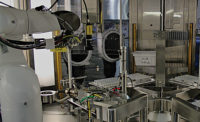In its latest report, BCC Research projects the global drug delivery market to grow to nearly $227.3 billion by 2020, with a compound annual growth rate of 4.9 percent. This is great news for the French company Nemera, which designs and manufactures world-class drug delivery devices for the pharmaceutical industry.
Founded in the early 1960s as Rexam Healthcare, Nemera currently operates manufacturing plants in La Verpillière and Le Tréport, France; Neuenburg, Germany; and Buffalo Grove, IL, in the United States. Only the Neuenburg location produces devices made of injection-molded thermoplastic. These products are assembled on rotary and linear high-speed lines using robots and ultrasonic welding, before being packed with automated equipment.
Several years ago, the production team at Neuenburg noticed that the plant’s rapid-injection molding and assembly machinery malfunctioned at higher speeds, but didn’t know why. Team members decided to explore ways to capture video images of the machinery operating, millisecond-by-millisecond, for analysis.
This initiative is part of the company’s good manufacturing practices (GMP), which ensures that quality is built into the organization and all of its manufacturing processes. GMP at Nemera includes control, quality, safety and effectiveness.
After researching several high-speed video cameras, three vendors were considered, including Mikrotron GmbH. Nemera asked each vendor to put its cameras through a battery of tests in identical scenarios. In the end, the Mikrotron MotionBLITZ Cube high-speed camera was deemed best thanks to its sharp resolution, ease-of-mobility and built-in circular buffer that makes it possible to capture video without any connection to a PC.
The camera exceeded expectations with its modular software architecture and convenient internal triggering functions. Its external control capability via machine signals also proved to be especially beneficial, as did the camera’s ImageBLITZ auto trigger. By reacting to specific changes in the image content, the camera is able to quickly and accurately capture even sporadically arising events.
Within six months of purchasing the MotionBLITZ camera, Nemera employees had carried out more than 25 studies in various areas of production. One study examined insulin syringe production, which occurs at a rate of up to 200 pieces per minute.
Workers noticed that components were being damaged at this high production speed, leading to machine disruptions and costly waste. When the machines were programmed for slower production, however, everything functioned perfectly. Unfortunately, the reason for this difference was not immediately apparent to the workers, so they continued to incorrectly position the syringe components and run production at the higher speed.
The Nemera study team then video recorded the machines at high speed with the MotionBLITZ and watched the film in slow motion. It clearly showed the problem: When the machine was operated at the production rate of 200 pieces per minute, the grippers that grip the syringe parts opened milliseconds too soon, and hit and damaged parts. Nemera’s team immediately reprogrammed the machine and improved efficiency by 10 percent.
Another application involved the ejection of contact-lens blister packs after molding. The pressing process kept faltering because one pack in each batch repeatedly got stuck on the pin. However, slow-motion video—originally taken at a speed of 500 frames per second by the MotionBLITZ camera—showed Nemera workers that the ejection interval time needed to be modified by a few milliseconds to eliminate the problem.
Many other equally difficult machine problems have been solved at Neuenburg during the last few years. In each case, the camera’s time-based conclusions were leveraged to accurately adjust the affected machine and achieve optimization.
As a result, the MotionBLITZ Cube is now part of the standard equipment that Nemera installs to detect machine problems and sources of errors. For more information on high-speed video cameras, call 858-774-1176 or visit www.mikrotron.de/en.








